详细介绍
EpiCorneal 3D人体组织模型(EpiCorneal 3D human tissu)
授权代理,现货供应,
EpiCorneal™
The EpiCorneal 3D human tissue model provides a highly predictive non-animal alternative to assess ophthalmic drug delivery, wound healing and tissue regeneration, disease modeling (e.g. dry eye) and corneal infection.
EpiCorneal™
The EpiCorneal 3D human tissue model provides a highly predictive non-animal alternative to assess drug delivery, infection, wound healing/tissue regeneration and disease modeling (i.e. Dry Eye).
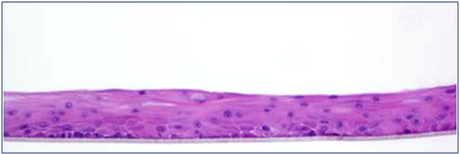
MatTek’s EpiCorneal tissue model consists of normal human corneal epithelial cells cultured to form a stratified, squamous epithelium which closely parallels normal human corneal tissue. The corneal cells, cultured on specially prepared cell culture inserts with serum-free medium, differentiate to form a multi-layered structure.
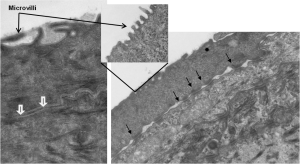 TEM Analysis of EpiCorneal illustrates the presence of 1) microvilli, 2) tight junctions (white arrows), and 3) desmosomes (black arrows)
TEM Analysis of EpiCorneal illustrates the presence of 1) microvilli, 2) tight junctions (white arrows), and 3) desmosomes (black arrows)
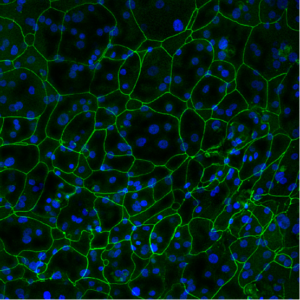 Tight Junction Protein ZO-1 (green)
Tight Junction Protein ZO-1 (green)
Used in drug delivery and drug development, EpiCorneal is a mitotically and metabolically active tissue with barrier properties approaching those of the human cornea. EpiCorneal can be stimulated to release many cytokines known to be important in inflammation and diseases such as dry eye. Further, the advanced 3D tissue model expresses cornea specific drug transporters and metabolizing enzymes.
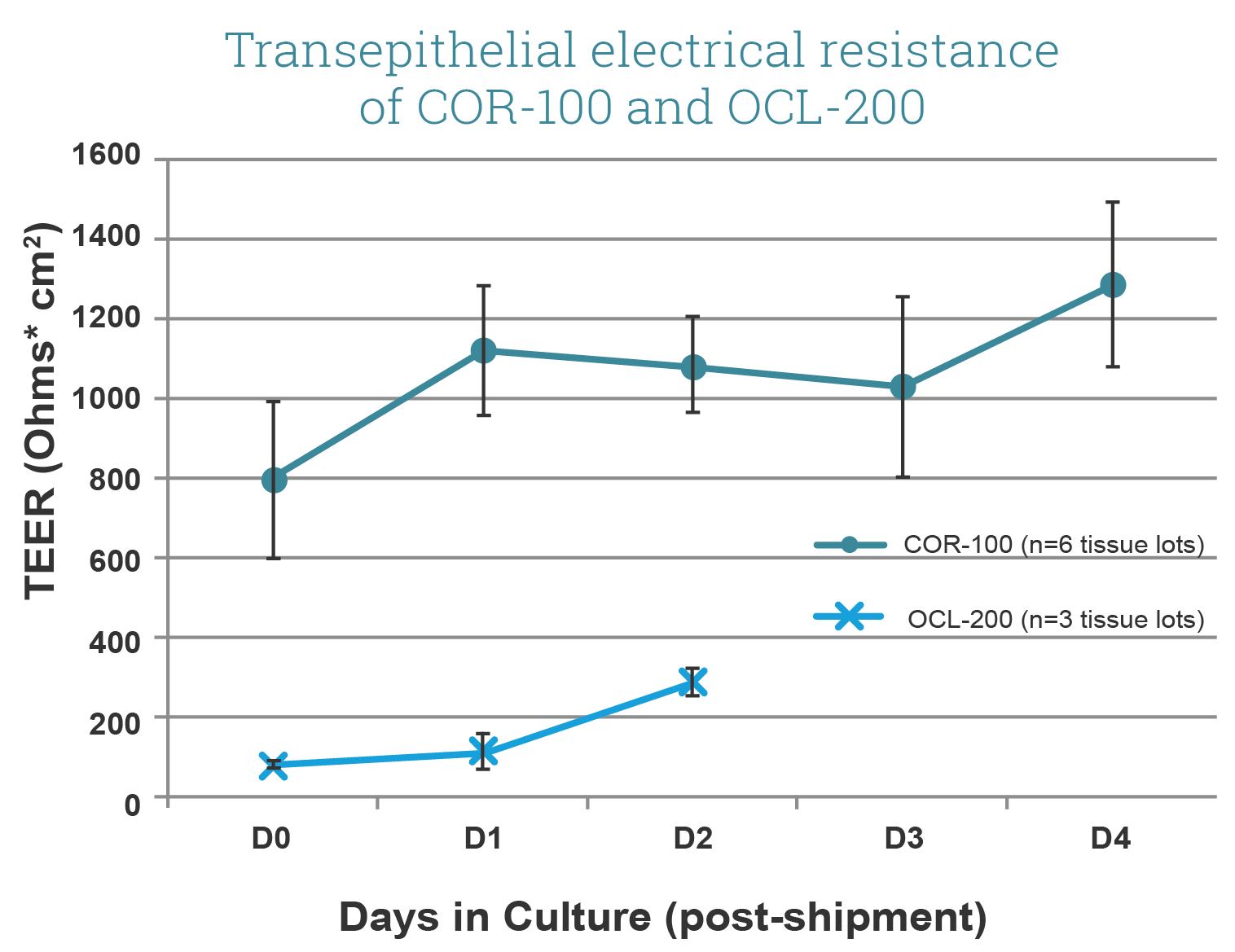 Barrier Properties of EpiCorneal compared to EpiOcular measured by transepithelial electrical resistance (TEER).
Barrier Properties of EpiCorneal compared to EpiOcular measured by transepithelial electrical resistance (TEER).
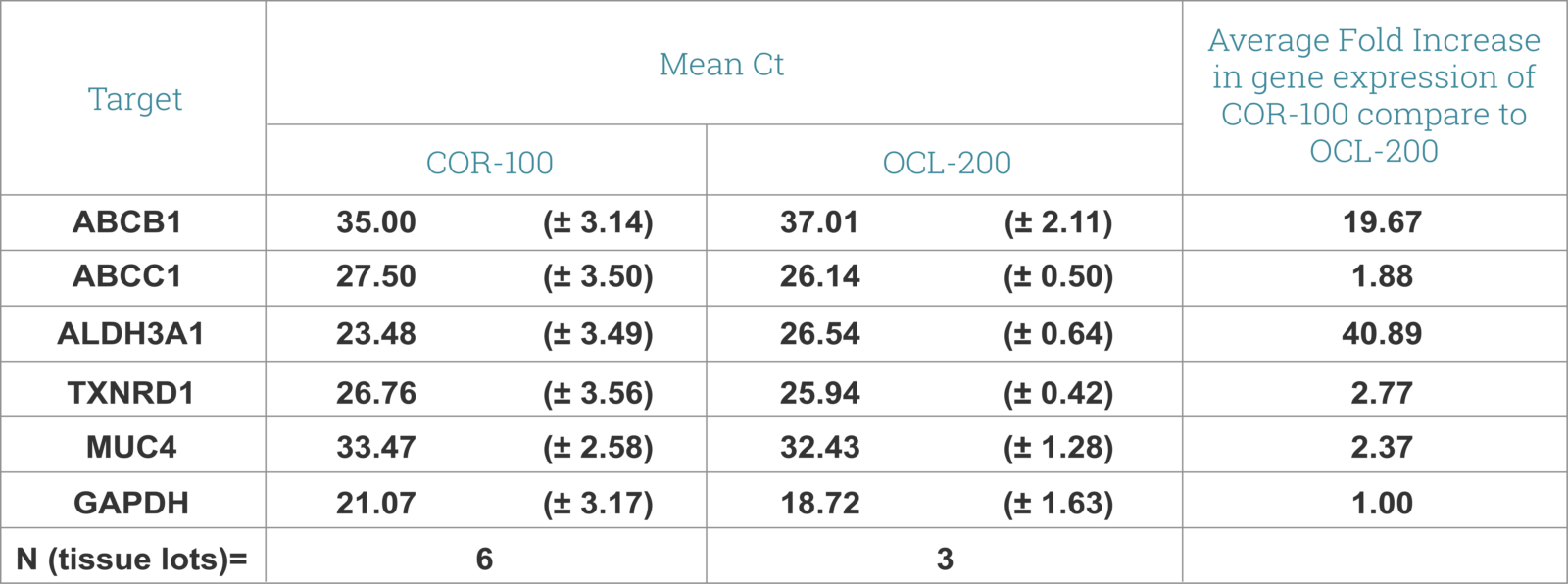 Gene Expression Analysis shows the expression of cornea specific markers, drug metabolizing enzymes and transporters including Aldehyde Dehydrogenase (ALDH3A1), Pyrimidine Nucleotide Oxidoreductase (TRXR1) and Mucin 4 (MUC4)
Gene Expression Analysis shows the expression of cornea specific markers, drug metabolizing enzymes and transporters including Aldehyde Dehydrogenase (ALDH3A1), Pyrimidine Nucleotide Oxidoreductase (TRXR1) and Mucin 4 (MUC4)
Tissue
Kit: A standard EpiCorneal kit (COR-100) consists of 24 tissues. (Tissue “kits” contain tissues, a small amount of culture medium, and plasticware; contact MatTek for specific kit contents)
Formats: 9mm individual inserts – tissue culture substrate is chemically modified with a pore size of 0.4 μm
Culture: Air-liquid interface
Histology: 4-5 cell layers – stratified, squamous morphology and tissue structure
Lot numbers: Tissue lots produced each week are assigned a specific lot number. A letter of the alphabet is appended to the end of the lot number to differentiate between individual kits within a given lot of tissues. All tissue kits within a lot are identical in regards to cells, medium, handling, culture conditions, etc.
Shipment: At 4°C on medium-supplemented, agarose gels
Shipment day: Every Monday
Delivery: Tuesday morning via FedEx priority service (US). Outside US: Tuesday-Thursday depending on location
Shelf life: Including time in transit, tissues may be stored at 4°C for up to 3 days prior to use. However, extended storage periods are not recommended unless necessary. In addition, the best reproducibility will be obtained if tissues are used consistently on the same day, e.g. Tuesday afternoon or following overnight storage at 4°C (Wednesday morning)
Cells
Type: Normal human corneal epithelial cells (HCEC)
Genetic make-up: Single donor
Derived from: Healthy donor
Screened for: HIV, Hepatitis-B, Hepatitis-C, mycoplasma
Medium
Base medium: Dulbecco’s Modified Eagle’s Medium (DMEM).
Growth factors/hormones: Epidermal growth factor, insulin, hydrocortisone and other proprietary stimulators of corneal epithelial differentiation.
Serum: None.
Antibiotics: Penicillin (50 U/ml) / Streptomycin (50 µg/ml)
Anti-fungal agent: Amphotericin B (0.125 µg/ml).
pH Indicator: Phenol red.
Alternatives: Phenol red-free, antibiotic/anti-fungal-free, or hydrocortisone-free medium and tissue are available. Agents are removed at least 3 days prior to shipment.
Maintenance medium: Most experiments with EpiCorneal™ are performed within 48 hours. However, for longer experiments, the tissue can be maintained in COR-100-MM (identical to EpiCorneal™ assay medium).
Quality Control and Sterility
Visual inspection: All tissues are visually inspected and if physical imperfections are noted, tissues are rejected for shipment
Sterility: All media used throughout the production process is checked for sterility. Maintenance medium is incubated with and without antibiotics for 1 week and checked for sterility. The agarose gel from the 24-well plate used for shipping is also incubated for 1 week and checked for any sign of contamination
Screening for pathogens: All cells are screened and are negative for HIV, hepatitis B and hepatitis C using PCR. However, no known test method can offer complete assurance that the cells are pathogen free. Thus, these products and all human derived products should be handled at BSL-2 levels (biosafety level 2) or higher as recommended in the CDC-NIH manual, “Biosafety in microbiological and biomedical laboratories,” 1998. For further assistance, please contact your site Safety Officer or MatTek technical service
Notification of lot failure: If a tissue lot fails our QC or sterility testing, the customer will be notified and the tissues will be replaced without charge when appropriate. Because our QC and sterility testing is done post-shipment, notification will be made as soon as possible (Under normal circumstances, ET-50 failures will be notified by Wednesday 5 p.m.; sterility failures will be notified within 8 days of shipment)
MatTek公司是麻省理工学院两个化学工程教授于1985成立的科技公司。1991年,该公司利用其核心的聚合物表面改性技术进入新兴的组织工程领域,目前已成长为的组织工程技术公司,致力于生产创新性的3D重构人体组织模型,该模型相较于传统2D细胞模型具有更可靠的实验结果。其生产的重构皮肤,眼部和呼吸道组织模型已广泛应用于化妆品,化工,医药和家用产品等行业的毒理学监控(OECD,欧盟的指导方针)及毒理学研究。
MatTek公司的基于人体细胞的3D皮肤模型EpiDerm于1993年研发上市,立即获得巨大的成功。从此MatTek通过以下方式*改变了基于人体细胞的体外模型市场:
(1)低成本(降低50-80%的成本);
(2)通过发表质量控制标准(同时具备阳性和阴性对照)以确保可为行业及监管机构接受的高可重复性水平;
(3)优化研究人员的实验结果。通过创造性使用非动物的体外测试,融合降低(直接/间接)成本的强大协同效应及显著提高的产品质量,MatTek极大的降低产品成本、提高实验室效率及高质量的高可重复性产品,减少实验动物的使用,具有无可超越的长期组织可重复性;3-D仿真结构;高度分化的组织模型;代谢和分裂活性;源于正常的人体细胞;培养、操作简便;无血清培养;可定量的客观检测;物美价廉的优点。因而使得MatTek人细胞来源的体外组织模型被包括美国、加拿大、欧洲、日本和东亚的众多跨国公司与研究机构采用。
目前MatTek公司的产品主要包括EpiDerm(皮肤模型)、MelanoDerm(黑色素模型)、EpiOcular(眼周表皮模型)、EpiAirway(呼吸道上皮模型)、EpiDermFT(全厚的皮肤模型) 、EpiVaginal(阴道上皮模型)、EpiOral(口腔上皮模型)、 EpiGingivalTM(牙龈上皮模型)、Psoriasis tissue(牛皮癣组织模型)及树突细胞。
 化工仪器网
化工仪器网


 化工仪器网
化工仪器网